| December 05, 2008 |  |
MarsDaily Advertising Kit |
| Previous Issues | Dec 04 | Dec 03 | Dec 02 | Dec 01 | Nov 28 |
Simulating Mars On Earth Moffett Field CA (SPX) Dec 05, 2008
Moffett Field CA (SPX) Dec 05, 2008The possibility of life on Mars has been debated almost since the invention of the telescope-annual growth and shrinkage of the martian ice caps and seasonal changes in color were observed by astronomers such as Herschel and Whewell in the 18th and 19th centuries. Late in the 19th century, Schiaparelli reported the existence of linear features he called "canali", and this led to ... more Ancient Climate Cycles Recorded In Mars Rocks  Pasadena CA (SPX) Dec 05, 2008
Pasadena CA (SPX) Dec 05, 2008Researchers at the California Institute of Technology (Caltech) and their colleagues have found evidence of ancient climate change on Mars caused by regular variation in the planet's tilt, or obliquity. On Earth, similar "astronomical forcing" of climate drives ice-age cycles. Using stereo topographic maps obtained by processing data from the high-resolution camera onboard NASA's Mars ... more NASA delays Mars mission until 2011  Washington (AFP) Dec 4, 2008
Washington (AFP) Dec 4, 2008US space agency NASA delayed a landmark mission to Mars by 26 months on Thursday, adding another 400 million dollars to the already over-budget project to see if the red planet can support life, officials said. "We will not be ready to launch Mars Science Lab by the hoped-for date next year," NASA administrator Michael Griffin told a news conference. A 2009 launch was ruled because it "would ... more NASA Finishes Listening For Phoenix Mars Lander  Pasadena CA (SPX) Dec 03, 2008
Pasadena CA (SPX) Dec 03, 2008After nearly a month of daily checks to determine whether Martian NASA's Phoenix Mars Lander would be able to communicate again, the agency has stopped using its Mars orbiters to hail the lander and listen for its beep. As expected, reduced daily sunshine eventually left the solar-powered Phoenix craft without enough energy to keep its batteries charged. The final communication from ... more Spirit Drained As Martian Dust Storms Continue  Pasadena CA (JPL) Dec 02, 2008
Pasadena CA (JPL) Dec 02, 2008Spirit's condition has improved during the past week, though skies remain fairly dusty after the recent Martian dust storm. Since sol 1730 (Nov. 14, 2008), solar-array energy has averaged 169 watt-hours (100 watt-hours is the amount of energy needed to light a 100-watt bulb for 1 hour). The latest measurement of atmospheric darkness caused by dust, known as Tau, is 0.858. The dust factor, repres ... more |
mars-mers
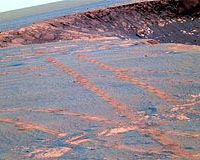 asteroid 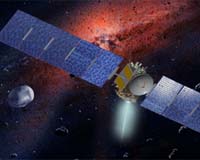 mars-general 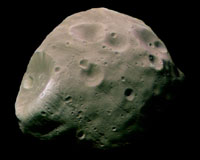 |
 Tempe AZ (SPX) Nov 27, 2008
Tempe AZ (SPX) Nov 27, 2008Mars has slipped far enough behind the sun today that signals from Mars-orbiting spacecraft are effectively blocked until mid-December. This solar conjunction happens every two years. Mars mission scientists - including the University of Arizona-based team that runs the High-Resolution Imaging Science Experiment, or HiRISE, instrument aboard NASA's Mars Reconnaissance Orbiter - will resume ... more Public Presentation About Mars Orbiter Images And Findings  Pasadena CA (SPX) Nov 27, 2008
Pasadena CA (SPX) Nov 27, 2008Mars scientists will present dramatic images and key findings from NASA's Mars Reconnaissance Orbiter at a free evening program in Pasadena on Thursday, Dec. 4, celebrating completion of the mission's first two-year science phase. The Mars Reconnaissance Orbiter has already collected more data than all other past and current Mars missions combined. Its findings point to a complex history ... more New tool to help find hidden meteorite craters  Ottawa (AFP) Nov 25, 2008
Ottawa (AFP) Nov 25, 2008Meteorite craters are a rare find on Earth, numbering only 175 at last count, but a Canadian researcher unveiled Tuesday a new computer tool for locating hundreds more from even the tiniest of clues. According to observations of the Moon and Mars, a small meteorite is predicted to impact Earth every 10 years. Mars Orbiter Camera has shown, for example, that at least 20 such impacts formed on ... more Solar Wind Rips Up Martian Atmosphere  Huntsville AL (SPX) Nov 25, 2008
Huntsville AL (SPX) Nov 25, 2008Researchers have found new evidence that the atmosphere of Mars is being stripped away by solar wind. It's not a gently continuous erosion, but rather a ripping process in which chunks of Martian air detach themselves from the planet and tumble into deep space. This surprising mechanism could help solve a longstanding mystery about the Red Planet. "It helps explain why Mars has so ... more |
mars-general
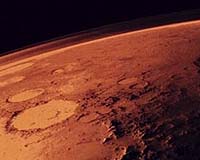 marsexpress 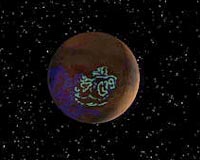 outerplanets 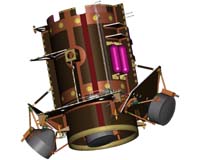 |
 Paris (AFP) Nov 20, 2008
Paris (AFP) Nov 20, 2008The International Space Station (ISS) next year will be commanded for the first time by a European, the European Space Agency (ESA) announced here on Friday. Belgian astronaut Frank de Winne will be taken aloft next May aboard a Russian Soyuz spacecraft, a`long with Russian cosmonaut Roman Romanenko and Canadia's Robert Thirsk, taking the ISS's full-time crew from three to six, ESA said in a ... more NASA Spacecraft Detects Buried Glaciers On Mars  Pasadena CA (SPX) Nov 21, 2008
Pasadena CA (SPX) Nov 21, 2008NASA's Mars Reconnaissance Orbiter has revealed vast Martian glaciers of water ice under protective blankets of rocky debris at much lower latitudes than any ice previously identified on the Red Planet. Scientists analyzed data from the spacecraft's ground-penetrating radar and report in the Nov. 21 issue of the journal Science that buried glaciers extend for dozens of miles from the edges ... more NASA marks 10th ISS anniversary with spacewalk  Washington (AFP) Nov 20, 2008
Washington (AFP) Nov 20, 2008Astronauts from the shuttle Endeavour marked the 10th anniversary of the International Space Station Thursday by exiting the station for the second of four spacewalks. The US space agency NASA said astronauts Heide Stefanyshyn-Piper and Shane Kimbrough left the ISS decompression chamber at 1658 GMT, some 45 minutes earlier than planned, for a spacewalk to last about 6.5 hours. ... more Evidence of vast frozen water reserves on Mars: scientists  Washington (AFP) Nov 20, 2008
Washington (AFP) Nov 20, 2008NASA scientists have discovered enormous underground reservoirs of frozen water on Mars, away from its polar caps, in the latest sign that life might be sustainable on the Red planet. Ground-penetrating radar used by the Mars Reconnaissance Orbiter reveals numerous huge glaciers up to one half-mile thick buried beneath layers of rock and debris. Researchers said one glacier is three time ... more
|
mars-general
 mars-general 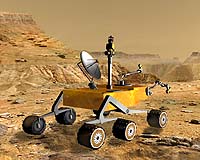 mars-general 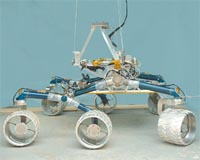 |
| Previous Issues | Dec 04 | Dec 03 | Dec 02 | Dec 01 | Nov 28 |
| The contents herein, unless otherwise known to be public domain, are Copyright 1995-2007 - SpaceDaily. AFP and UPI Wire Stories are copyright Agence France-Presse and United Press International. ESA Portal Reports are copyright European Space Agency. All NASA sourced material is public domain. Additional copyrights may apply in whole or part to other bona fide parties. Advertising does not imply endorsement, agreement or approval of any opinions, statements or information provided by SpaceDaily on any web page published or hosted by SpaceDaily. Privacy statement |